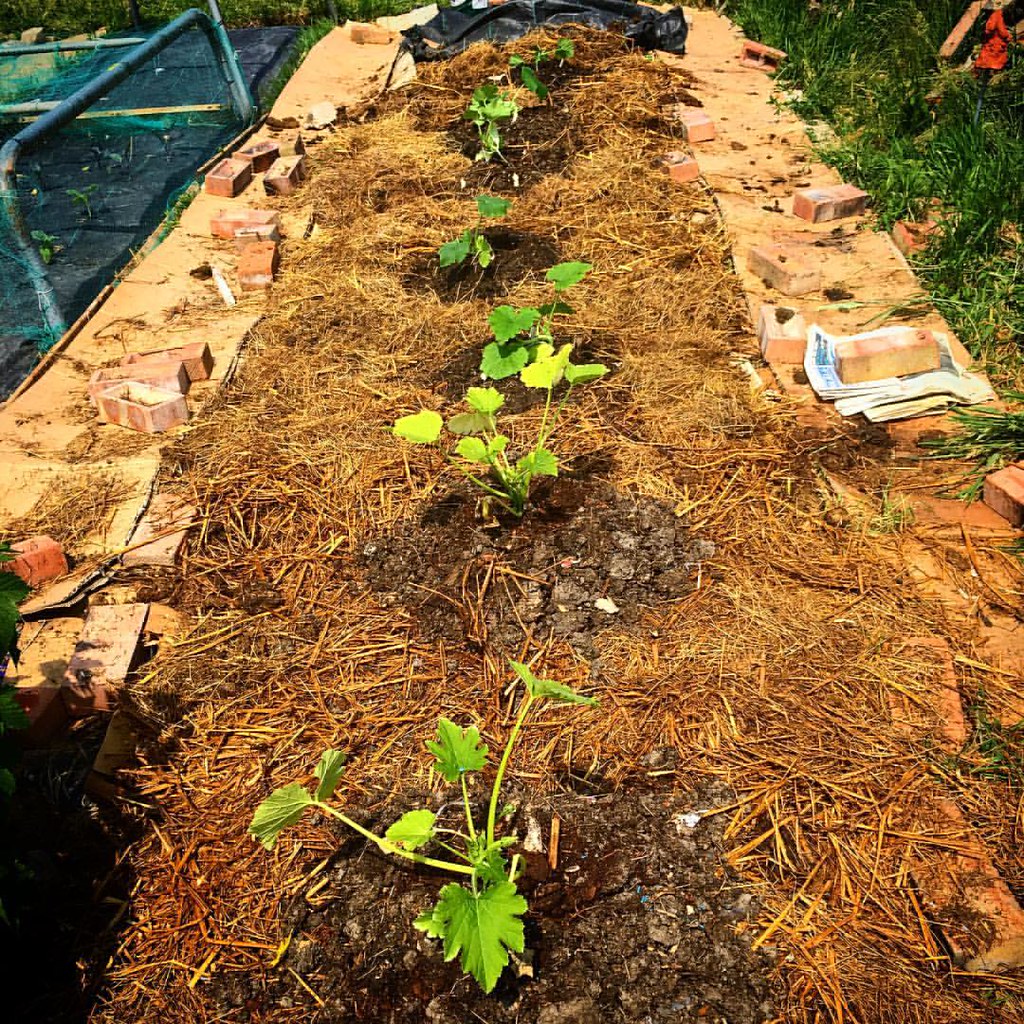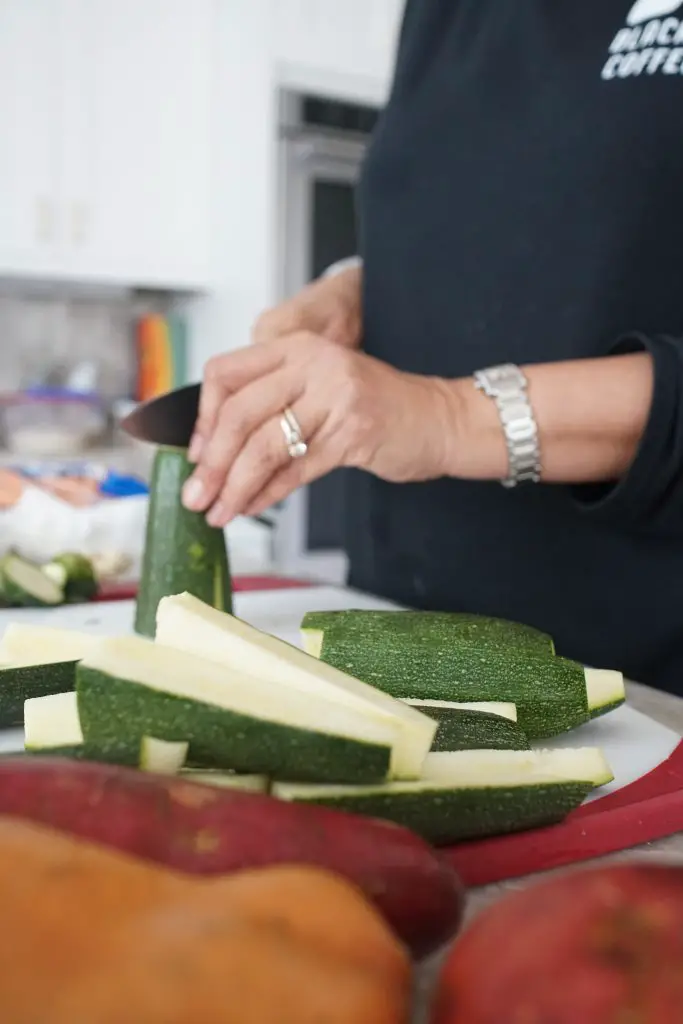How Much Does One Zucchini Plant Yield? Zucchini, also known as courgettes, are an extremely popular vegetable that is grown widely in vegetable gardens and is often the vegetable that inexperienced gardeners start off with first. Zucchini is renowned for being a large producer of fruit and will produce masses of fruit throughout the season but how much does an individual zucchini plant actually produce in a single season?
Zucchini plants produce between 4 and 16lbs (2 and 8kg) of fruit per season depending upon the conditions in which they are grown according to a study by the University of Marylands. However, I have generally found that the volume of the fruit that you get is more often at the upper part of this range or even exceeds it in some cases.
The reason that I think that I generally get higher yields than those in the study by the University of Maryland is because I am an amateur home gardener that tends to not pick the plants as frequently as I should be so I end up with very large zucchinis at the end of every season.
In contrast the University of Maryland has been assessing the volume of zucchinis produced based upon commercial practices which require the zucchini to be picked at a relatively young age which means that the amount of mass that you get is reduced but the quality is better.

It is also important to note that the numbers provided are based upon a calculation as the study used only the dry mass of the fruit. To get an indication of the weight of the fruit coming off the plants we estimated that the fruit contains 94% water which is a common number that is quoted by a range of sources.
Irrespective of how you grow the plants it is important to note that they are among the best yielding vegetable plants in the garden and are well worth planting.
How To Grow Zucchini
Zucchini plants are extremely easy to grow and as mentioned above will produce masses of fruit in a single year. For a family of 4 to 5 typically 3 plants are more than enough to produce all the zucchini you can eat and store in a given year with plenty leftover to give two friends.
Given, that you only need 3 plans I often just buy seedlings from the local garden centre as you often only need one punnet. However, it is also extremely easy to also grow the plants from seed.
The best time to sow seed is in spring when the weather is starting to warm up, however, you may also consider planting them a little bit earlier indoors if you want to try and get a harvest more quickly.

Start by filling up the seed tray with a good quality seed raising mix and plant 2 seeds per cell in a seed tray at a depth of approximately 1 inch. As you don’t really need many plants to produce a large crop we generally recommend not using a full seed tray for this plant but rather a little six-pack seed tray as that will produce more than enough plants for your needs.
Once the seeds are planted you typically expect to see the seedlings appear in around a week, however, this will depend upon the conditions in which the seeds are grown. The seedlings are relatively large and will develop in a period of approximately 4 to 6 weeks to the point where they can be planted out into the garden.
The seedlings can only go out into the garden once the risk of frost has passed as these plants are frost-sensitive. As the plants are relatively large they should be planted approximately 2 to 3 ft apart in a garden bed as they will quickly fill up that space throughout the season.
Ideally, the garden bed that they planted in should get 6 to 8 hours of sun a day and contain soil that is rich moist, and free draining with plenty of nutrients. If you are unsure about the quality of your soil it is advisable to add a bag of compost to the soil.
When the seedlings go in it is imperative that you provide protection against slugs or snails because these plants are particularly susceptible to attack. This can be done either by sprinkling snail bait around the plants or alternatively applying a cloche over the plants which will provide a physical barrier.
Once the plants have started to become established and a beginning to develop and size they are generally less susceptible to attack from pests. At this point, the main thing to focus on is ensuring that the plant has plenty of water and the soil around it is mulched well to suppress weeds.
How To Maximize The Yield of Zucchini Plants,
Once the plant is fully established it will start to produce female flowers and also male flowers, which in most normal circumstances, will pollinate each other to produce the fruit. However, if you want to maximize the output of a given plant it is a good idea to also hand pollinate the flowers as this will increase the number of fruit that mature on the plant.
To do this simply pick a male flower, which is the flower that does not have a fruit attached to it, and rub the centre of the flower onto a number of the female flowers that are most commonly open in the morning. Carrying out this activity will guarantee that you get additional fruit.
The other important factor that can increase the yield significantly is to ensure that you keep on top of picking the zucchinis regularly. Most gardeners this means at the start of the season they are picking extremely regularly because it is the first fruit of the season. However, as the zucchini begins to arrive in large numbers the frequency of picking tends to trailer off resulting in reduced numbers of zucchini, which are larger.
The larger zucchini is generally not as tender as the young ones so you tend to get a reduction in quality overtime throughout the season.

What To Do With A Glut Of Zucchini
Most people that grow zucchini end up having a glut of them towards mid to late summer as the plant really gets going. At this stage, it is also common to end up with zucchinis that are absolutely enormous because they do go from moderately sized to over a foot long in a very short period in warm weather. So do you with the excess zucchini?
The most common method that we use at home is to firstly grate the zucchini and freeze it in individual bags ready to be added to bolognese sauces which we make in winter. The easiest way to shred the zucchini is to use a food processor with the grater blade as that will make light work of the zucchinis in a matter of minutes.
The grated zucchini can then be packaged off into individual snaplock bags and frozen. This method is particularly suitable for dealing with zucchini that have got too large. The problem with the largest zucchinis is that they have fully mature it seeds inside the fruit which can become very hard and inedible.
However, if you have fruit like this you can simply cut out the center of the fruit before processing it to ensure that there are no seeds in the grated zucchini that you produce.
The second method that we often use is to make zucchini pickle which is a fantastic way to preserve zucchini in jars rather than in freezers where there is limited space. The particular zucchini recipe that we use is listed below;
Ingredients
1 kg of grated zucchini
1 kg of sliced onions
1 cup of sugar
1 teaspoon of turmeric
2 cups of vinegar
1 teaspoon of mustard seeds
1 teaspoon of salt
Method
- Step 1 Grate the zucchini and slice the onion and placing them into a bowl
- Step 2 Sprinkle the salt on the zucchini and onion mixture and leave it for approximately 2 hours
- Step 3 Drain the liquid from the zucchini and onion mixture and transfer it into a cooking pot
- Step 4 Add the vinegar, sugar, turmeric, and mustard seeds to the mixture
- Step 5 Bring the mixture to the boil for approximately 5 minutes
- Step 6 While the mixture is still hot transfer it into sterilize jars and seal it immediately
- Step 7 Store the jars in a cool darkplace
Beyond long-term pickling, the other option is to use zucchini to make things like zucchini spaghetti or also zucchini fritters which will also help to use up your excess produce,
I hope you found this article useful and have great success with your zucchini, if you have any additional questions please leave them in the section below.
Relevant Articles
Do You Need Two Zucchini Plants To Get Fruit?
What Is The Difference Between Dwarf Beans and Climbing Beans?
How To Prevent Weeds From Growing
When Should I Plant Winter Vegetables?
